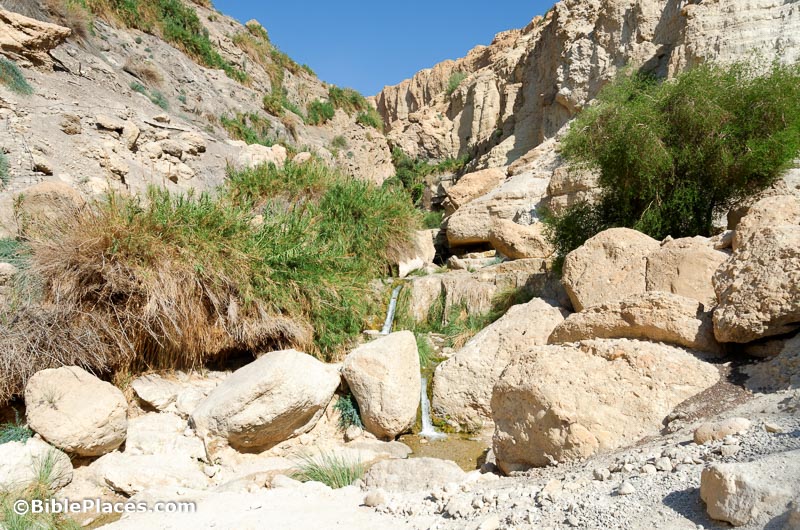In a nutshell, Ancient Jerusalem Revealed: Archaeological Discoveries, 1998-2018 is a summation of the results of a couple dozen excavations all over Jerusalem. Each article is written by the excavator(s), with the result that you feel like you’re standing at the site, getting the final synopsis of what they discovered. The volume is loaded with photographs and diagrams.
My intention is to summarize a few of these articles in upcoming posts. There are four articles from the “Old Testament” period (Bronze and Iron Ages), and today’s post is about the first one.
Ronny Reich and Eli Shukron excavated in the City of David for 14 years (1995-2008), and their chapter on “Recent Discoveries in the City of David” focuses on two subjects: (1) the rock-cut pool and (2) the Gihon Spring fortifications. Both of these are in close proximity to each other, and both of them have proven quite difficult to understand.
The Rock-Cut Pool was not a pool, but its walls chiseled into the bedrock at a height of [oops – the article doesn’t even say; I’ll guess 20 feet] are amazing. But holes in the bedrock, even really large ones, do not tell stories, and so the excavators focus all of their attention on what they found inside the “pool,” which necessarily dates to a period later than the “pool’s” earliest use.
What did they find inside the pool? (1) Lots of pottery, mostly from around 825-750 BC, which was tossed in from the surrounding area when someone built (2) a house. Yes, this seems like a strange place to build a house, but someone did. The excavators compared it to the house of Ahiel in Area G.
(3) Fish bones. A lot of fish bones. And strangely enough, this is the only place in Jerusalem where they have found lots of fish bones. Of the 10,600 fish bones, they identified 14 different fish families, but the favorites on Jerusalem dining tables were Sparidae (porgies) and Mugilidae (mullets). All of these were obviously imported, and a study of their size indicates that only small fish were transported, possibly because of the need to package them for transport up into the hill country by donkey.
(4) About ten seals and scarabs as well as fragments of more than 170 seal impressions. Because they were from an earlier period than the collection found in Area G, they did not have inscriptions in any Semitic languages. A few had Egyptian inscriptions. And there were some cool decorations such as boats, fish, sphinxes, and palmettes. The archaeologists believe that an administrative center existed near the Rock-Cut Pool. (5) An ivory pomegranate with a dove perched on top.
The archaeologists believe that these finds point to ties with Phoenicia, a proposal which corresponds with the presence of Queen Athaliah (the daughter of a Phoenician princess). The article only hints at the possibilities here, but the date seems to line up.
The second major subject of the article is the Gihon Spring fortifications. The main point of this discussion is that the Pool Tower is not a tower but a fortified passageway. Now this passageway is very impressive, with its northern wall preserved to a height of 25 feet! They traced the parallel walls for 75 feet before they had to stop because of modern obstructions. The problem is that the excavators cannot figure out what this (obviously expensive) fortification did, and they seem to conclude that it went out of use before it came into use, being replaced by a subterranean equivalent known as “Warren’s Shaft.” All of this they date to the Middle Bronze Age.
The authors are honest, and I appreciate that. Here’s a sample paragraph that reflects their wrestling with the difficulties:
The key question is: How did those drawing water reach the place above the northeastern corner of the Rock-Cut Pool? Did they descend from the city between the two parallel walls, or perhaps through the subterranean tunnel (of the Warren’s Shaft complex), to emerge from it at the eastern end of those two walls, and then turn south toward the deepest part of the Rock-Cut Pool? Were these routes perhaps in use at different periods of time? We have no stratigraphic data that might point to such a sequence of phases of use and they should, therefore be interpreted based upon contemporary logic.
I’m not too impressed with the use of logic in archaeological interpretation, but it’s nice that they don’t pretend that they have evidence that they don’t.
I’ll conclude where they conclude, with what I see as an astonishing admission of our lack of knowledge about the most basic question of them all: where was the city of Jerusalem at this time?
Answer: the city may have been north of these fortifications. Or it may have been south. The fortified passageway may be in the southeastern corner of the fortified urban area, or it may have been in the northeastern corner. I guess I’m just glad that the Kidron Valley is on the east side of their excavation, or we probably wouldn’t even know if this was the eastern or western side of the city!
If you like a little bit more certainty (or a lot!) in your archaeology, check back next week for my summary of Eilat Mazar’s excavation of the palace of David.

